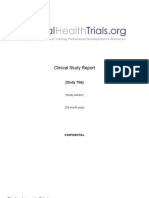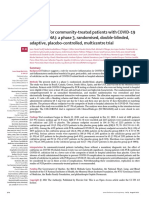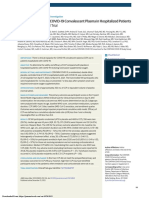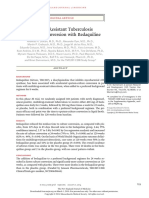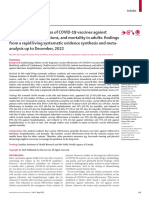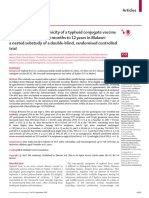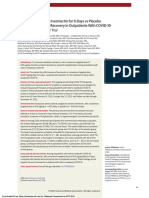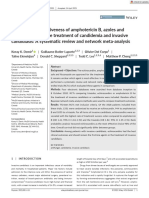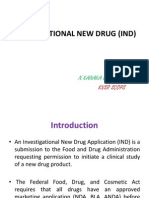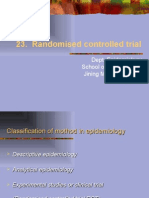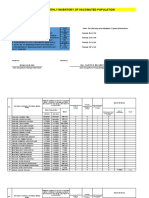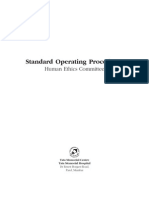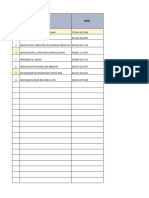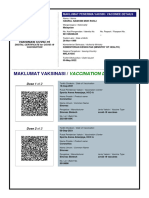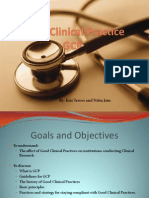C19 Useless Antiviral
C19 Useless Antiviral
Uploaded by
2jbkrf5bkcCopyright:
Available Formats
C19 Useless Antiviral
C19 Useless Antiviral
Uploaded by
2jbkrf5bkcCopyright
Available Formats
Share this document
Did you find this document useful?
Is this content inappropriate?
Copyright:
Available Formats
C19 Useless Antiviral
C19 Useless Antiviral
Uploaded by
2jbkrf5bkcCopyright:
Available Formats
Articles
Molnupiravir plus usual care versus usual care alone as early
treatment for adults with COVID-19 at increased risk of
adverse outcomes (PANORAMIC): an open-label, platform-
adaptive randomised controlled trial
Christopher C Butler*, F D Richard Hobbs*, Oghenekome A Gbinigie, Najib M Rahman, Gail Hayward, Duncan B Richards, Jienchi Dorward,
David M Lowe, Joseph F Standing, Judith Breuer, Saye Khoo, Stavros Petrou, Kerenza Hood, Jonathan S Nguyen-Van-Tam, Mahendra G Patel,
Benjamin R Saville, Joe Marion, Emma Ogburn, Julie Allen, Heather Rutter, Nick Francis, Nicholas P B Thomas, Philip Evans, Melissa Dobson,
Tracie-Ann Madden, Jane Holmes, Victoria Harris, May Ee Png, Mark Lown, Oliver van Hecke, Michelle A Detry, Christina T Saunders,
Mark Fitzgerald, Nicholas S Berry, Lazaro Mwandigha, Ushma Galal, Sam Mort, Bhautesh D Jani, Nigel D Hart, Haroon Ahmed, Daniel Butler,
Micheal McKenna, Jem Chalk, Layla Lavallee, Elizabeth Hadley, Lucy Cureton, Magdalena Benysek, Monique Andersson, Maria Coates,
Sarah Barrett, Clare Bateman, Jennifer C Davies, Ivy Raymundo-Wood, Andrew Ustianowski, Andrew Carson-Stevens, Ly-Mee Yu†, Paul Little†,
for the PANORAMIC Trial Collaborative Group‡
Summary
Background The safety, effectiveness, and cost-effectiveness of molnupiravir, an oral antiviral medication for Published Online
SARS-CoV-2, has not been established in vaccinated patients in the community at increased risk of morbidity and December 22, 2022
https://doi.org/10.1016/
mortality from COVID-19. We aimed to establish whether the addition of molnupiravir to usual care reduced hospital S0140-6736(22)02597-1
admissions and deaths associated with COVID-19 in this population.
See Online/Comment
https://doi.org/10.1016/
Methods PANORAMIC was a UK-based, national, multicentre, open-label, multigroup, prospective, platform adaptive S0140-6736(22)02593-4
randomised controlled trial. Eligible participants were aged 50 years or older—or aged 18 years or older with relevant *These authors contributed
comorbidities—and had been unwell with confirmed COVID-19 for 5 days or fewer in the community. Participants equally
were randomly assigned (1:1) to receive 800 mg molnupiravir twice daily for 5 days plus usual care or usual care only. †These authors contributed
equally
A secure, web-based system (Spinnaker) was used for randomisation, which was stratified by age (<50 years vs
≥50 years) and vaccination status (yes vs no). COVID-19 outcomes were tracked via a self-completed online daily diary ‡Members listed at end of paper
for 28 days after randomisation. The primary outcome was all-cause hospitalisation or death within 28 days of Nuffield Department of
Primary Care Health Sciences
randomisation, which was analysed using Bayesian models in all eligible participants who were randomly assigned. (Prof C C Butler FMedSci,
This trial is registered with ISRCTN, number 30448031. Prof F D R Hobbs FMedSci,
O A Gbinigie DPhil,
Findings Between Dec 8, 2021, and April 27, 2022, 26 411 participants were randomly assigned, 12 821 to molnupiravir G Hayward DPhil,
J Dorward MBChB,
plus usual care, 12 962 to usual care alone, and 628 to other treatment groups (which will be reported separately). Prof S Petrou PhD,
12 529 participants from the molnupiravir plus usual care group, and 12 525 from the usual care group were included Prof M G Patel PhD, E Ogburn,
in the primary analysis population. The mean age of the population was 56·6 years (SD 12·6), and 24 290 (94%) of J Allen BA, H Rutter BSc,
25 708 participants had had at least three doses of a SARS-CoV-2 vaccine. Hospitalisations or deaths were recorded in J Holmes PhD, V Harris PhD,
M E Png PhD, O van Hecke DPhil,
105 (1%) of 12 529 participants in the molnupiravir plus usual care group versus 98 (1%) of 12 525 in the usual care L Mwandigha PhD, U Galal MSc,
group (adjusted odds ratio 1·06 [95% Bayesian credible interval 0·81–1·41]; probability of superiority 0·33). There S Mort PGCert, M McKenna BSc,
was no evidence of treatment interaction between subgroups. Serious adverse events were recorded for 50 (0·4%) of J Chalk PhD, L Lavallee MPH,
12 774 participants in the molnupiravir plus usual care group and for 45 (0·3%) of 12 934 in the usual care group. E Hadley MSc, L Cureton BSc,
M Benysek MSc, M Coates,
None of these events were judged to be related to molnupiravir. S Barrett, C Bateman BA,
J C Davies PhD,
Interpretation Molnupiravir did not reduce the frequency of COVID-19-associated hospitalisations or death among I Raymundo-Wood BSc,
high-risk vaccinated adults in the community. L-M Yu DPhil), Oxford
Respiratory Trials Unit, Nuffield
Department of Medicine
Funding UK National Institute for Health and Care Research (Prof N M Rahman DPhil,
M Dobson BSc), Chinese
Academy of Medical Sciences
Copyright © 2022 The Author(s). Published by Elsevier Ltd. This is an Open Access article under the CC BY 4.0 license.
Oxford Institute
(Prof N M Rahman), and
Introduction that was initially developed for influenza,1 but has Nuffield Department of
Early treatment of COVID-19 with direct-acting antiviral subsequently been assessed as a treatment of Orthopaedics, Rheumatology
and Musculoskeletal Sciences
drugs in the community could plausibly prevent COVID-19.2 Molnupiravir is a prodrug: the
(Prof D B Richards DM),
deterioration, speed up recovery, and reduce health-care ribonucleoside analogue β-d-N4-hydroxycytidine is University of Oxford, Oxford,
use in the community, viral shedding, and, the need for metabolised to its triphosphate form in cells, and then UK; Oxford National Institute
hospital admission. Molnupiravir is an oral antiviral competes with the naturally occurring nucleotides for Health and Care Research
www.thelancet.com Published online December 22, 2022 https://doi.org/10.1016/S0140-6736(22)02597-1 1
Articles
Biomedical Research Centre,
Oxford, UK (Prof N M Rahman); Research in context
Centre for the AIDS Programme
of Research in South Africa Evidence before this study (both vaccinated and unvaccinated), time to a negative PCR
(CAPRISA), University of We searched PubMed with the terms (randomised OR trial) test was shorter in the molnupiravir group than in the placebo
KwaZulu–Natal, Durban, AND (molnupiravir) AND (COVID* OR SARS-CoV-2 OR group (8 days vs 11 days), but this difference was not
South Africa (J Dorward);
SARS-CoV) AND (systematic review) for articles published in significant.
Institute of Immunity and
Transplantation, University any language up to Sept 5, 2022. Our search identified
Added value of this study
College London, London, UK ten results. The two most comprehensive reviews were living
(D M Lowe PhD); Infection, Molnupiravir did not reduce hospitalisations or deaths in a
reviews synthesising the findings of six trials of molnupiravir
Inflammation and community-based vaccinated adult population with COVID-19
compared with either standard of care or placebo.
Immunology, UCL Great who were at increased risk of an adverse outcome, either overall
Ormond Street Institute of These reviews suggested that molnupiravir reduces the
or in any patient subgroups. However, molnupiravir was
Child Health, London, UK frequency of hospital admissions in patients with mild-to-
(Prof J F Standing PhD, associated with reduced time to recovery overall and for key
moderate COVID-19. WHO’s living guideline recommends use
Prof J Breuer MD); Department individual symptoms, reduced health-care seeking for some
of molnupiravir in outpatients with mild-to-moderate
of Pharmacy, Great Ormond primary care services, and reduced viral load. Trials of
Street Hospital for Children, COVID-19 who are at the highest risk of hospital admission.
molnupiravir have previously been done in largely unvaccinated
London, UK (Prof J F Standing); The largest randomised clinical trial identified by the evidence
Department of Pharmacology, participants before the emergence of the omicron variant.
syntheses was the placebo-controlled, phase 3 MOVe-OUT trial.
University of Liverpool, Our trial provides an estimate of the effectiveness of
In this trial of 1433 unvaccinated outpatients with COVID-19,
Liverpool, UK molnupiravir in a multiply vaccinated population when the
(Prof S Khoo FRCP); Centre for molnupiravir was associated with a relative reduction of
omicron SARS-CoV-2 strain was dominant.
Trials Research roughly 30% in the primary outcome—hospitalisations and
(Prof K Hood PhD, deaths—up to 29 days after randomisation. Notably, the Implications of all the available evidence
T-A Madden PhD) and Division
of Population Medicine
reduction in hospitalisations and deaths had been closer to The use of molnupiravir to treat confirmed SARS-CoV-2
(H Ahmed PhD, 50% in the trial’s interim analysis (after 762 participants had infection in vaccinated adults who are at increased risk of an
Prof A Carson-Stevens PhD), been recruited). The reason for this difference is unclear. Several adverse outcomes when omicron was the dominant circulating
Cardiff University, Cardiff, UK; trials of molnupiravir have been done in India, but full peer- variant did not reduce hospital admissions or deaths, both of
Lifespan and Population Health
Unit, University of Nottingham
reviewed findings have not yet been published. In the which are already very infrequent, but did reduce time to
School of Medicine, AGILE CST-2 trial, which included 180 participants recovery (and viral detection and load in a substudy).
Nottingham, UK
(Prof J S Nguyen-Van-Tam,
FMedSci); Berry Consultants,
Austin, TX, USA (B R Saville PhD,
cytidine triphosphate and uridine triphosphate.3 Once Methods
J Marion PhD, M A Detry PhD, incorporated into viral RNA, the errant nucleotide Study design and participants
C T Saunders PhD, induces so-called viral error catastrophe, impeding viral PANORAMIC is a national, multicentre, primary care,
M Fitzgerald PhD, fitness and inhibiting replication.3 Molnupiravir has open-label, multigroup, prospective, platform adaptive
N S Berry PhD); Department of
shown anti-SARS-CoV-2 activity in animal models,4–6 trial of early treatments for COVID-19 in the UK. The trial
Biostatistics, Vanderbilt School
of Medicine, Nashville, TN, USA and was safe and well tolerated at a dose of 800 mg twice opened for recruitment on Dec 8, 2021, and is ongoing.
(B R Saville); Primary Care daily in phase 1 human trials7,8 and phase 2 and 3 Full details of the protocol are in the appendix (p3).
Research Centre, University of outpatient trials.2,9,10 Platform trials allow for multiple treatments for the same
Southampton, Southampton,
The largest trial of molnupiravir so far is MOVe-OUT,10 disease to be tested simultaneously. A master protocol
UK (Prof N Francis PhD,
M Lown PhD, a placebo-controlled, industry-funded phase 3 trial in defines prospective decision criteria for stopping
Prof P Little FMedSci); Windrush unvaccinated, non-hospitalised patients with COVID-19 randomi sation to interventions for futility, declaring
Medical Practice, Witney, UK at high risk of adverse outcomes. The final results interventions superior, or adding new interventions.13
(N P B Thomas FRCGP); National
Institute for Health and Care
suggest a 30% reduction in hospital admissions and Interventions assessed in PANORAMIC include
Research Clinical Research deaths with molnupiravir treatment compared with molnupiravir (from December, 2021, to April, 2022)
Network: Thames Valley and placebo.10 Phase 3 trials in non-hospitalised patients in and nirmatrelvir–ritonavir (which remains open to
South Midlands, Oxford, UK India had mixed findings,11 but the full peer-reviewed recruitment as of December, 2022). However, there were
(N P B Thomas); Royal College
of General Practitioners,
results of these trial have yet to be published. The no trial adaptations, and there was only a short period of
London, UK (N P B Thomas); AGILE CST-2 trial,12 which included 180 vaccinated and overlap with nirmatrelvir–ritonavir recruitment while
Faculty of Health and Life unvaccinated participants, suggested that molnupiravir participants were being recruited to the interventions
Sciences, University of Exeter, was associated with a shorter time to a negative PCR test discussed in the Article.
Exeter, UK (Prof P Evans FRCGP);
National Institute for Health
compared with placebo (8 days vs 11 days), although this Eligible people were in the community (ie, not in
and Care Research Clinical difference was not significant. hospital), aged 50 years or older (or 18 years or older with
Research Network, Leeds, UK The effectiveness of molnupiravir in vaccinated relevant comorbidities; appendix p 14), had COVID-19
(Prof P Evans); General Practice patients in the community at increased risk of morbidity symptoms that had started within the previous 5 days,
and Primary Care, School of
Health and Wellbeing, College
and mortality from COVID-19 has not yet been and had had a positive PCR or rapid antigen SARS-CoV-2
of Medical, Veterinary & Life established. We aimed to assess the effectiveness of test within the past 7 days. People were excluded from
Sciences, University of molnupiravir in reducing hospital admissions or death, participating if they were pregnant or breastfeeding, of
Glasgow, Glasgow, UK or both, in this population. childbearing potential and unwilling to use effective
2 www.thelancet.com Published online December 22, 2022 https://doi.org/10.1016/S0140-6736(22)02597-1
Articles
contraception, already taking molnupiravir, or allergic to randomly assigned (1:1) by medical or research (B D Jani PhD); School of
molnupiravir. The complete inclusion and exclusion professionals to receive molnupiravir plus usual care or Medicine, Dentistry and
Biomedical Sciences, Queen’s
criteria are in the appendix (p 14). usual care only. A secure, web-based system (Spinnaker)
University Belfast, Belfast, UK
The UK Medicines and Healthcare products Regulatory was used for randomisation, which was stratified by age (Prof N D Hart MD,
Agency and the South Central-Berkshire Research Ethics (<50 years vs ≥50 years) and vaccination status (yes vs no). D Butler MBChB); Department
Committee of the Health Research Authority approved Participants and members of the trial team responsible of Microbiology, Oxford
University Hospitals NHS
the trial protocol. Online informed consent was obtained for recruitment, follow-up, and monitoring of participants Foundation Trust, Oxford, UK
from all participants. We vouch for the accuracy and were aware of group assignment. Trial investigators and (M Andersson MD); and
completeness of the data and for fidelity to the protocol. recruiting clinicians were masked to emerging results; Regional Infectious Diseases
An independent trial steering committee and data and only unmasked statisticians and the independent Unit, North Manchester
General Hospital,
safety monitoring committee provided trial oversight. members of the data and safety monitoring committee Manchester, UK
were granted access to unmasked results until the (Prof A Ustianowski PhD)
Randomisation and masking decision was made to close recruitment to molnupiravir. Correspondence to:
Potentially eligible people were screened, recruited, and Prof Christopher C Butler,
enrolled via 65 PANORAMIC General Practice Hubs Procedures Nuffield Department of Primary
Care Health Sciences, University
encompassing 4509 general practices across the UK. Participants in the molnupiravir group were asked to take of Oxford, Oxford OX2 6GG, UK
Participants were also recruited online and by telephone 800 mg molnupiravir orally twice daily for 5 days. These christopher.butler@phc.ox.
by the central trial team. Eligible participants were participants were urgently couriered a participant pack ac.uk
See Online for appendix
112 748 people screened for eligibility
44 246 ineligible
68 502 put forward for general practitioner eligibility check
42 091 not recruited
38 937 ineligible
2073 could not be contacted
374 recovered or symptoms resolving or resolved
270 no longer wished to take part
289 already received or receiving COVID-19 treatment
45 did not wish to take trial medication
22 not suitable for medical reasons
15 not registered with general practitioner or not living in UK
16 registration errors
50 other reasons
26 411 randomly assigned
12 821 assigned to molnupiravir plus usual care 12 962 assigned to usual care 628 assigned to other treatment groups*
47 ineligible 28 ineligible
12 774 in molnupiravir plus usual care group 12 934 in usual care group
245 excluded from analysis 409 excluded from analysis
122 withdrew consent to access medical 226 withdrew consent to access medical
notes notes
101 lost to follow-up 143 lost to follow-up
22 withdrew for other reasons 40 withdrew for other reasons
12 529 included in primary analysis 12 525 included in primary analysis
Figure 1: Trial profile
*Results related to these groups are not discussed in this Article.
www.thelancet.com Published online December 22, 2022 https://doi.org/10.1016/S0140-6736(22)02597-1 3
Articles
containing molnupiravir (along with dosing and safety sampling cohort were asked to provide daily nasal or
information) and a pregnancy test (only for use by pharyngeal swabs for the first 7 days and on day 14 (or
participants of childbearing potential). Participants in day 13 or 15). In the non-intensive sampling cohort,
both groups were emailed or posted a trial information participants were asked to provide nasal or pharyngeal
booklet. Usual care in the UK National Health Service swabs on days 1, 5 (or day 4 or 6) and 14 (or day 13 or 15).
(NHS) for COVID-19 in the community is largely focused Participants in the molnupiravir plus usual care group
on managing symptoms with antipyretics.14 However, were asked to take their first sample before the first dose
patients at very high risk (ie, those with impaired immune of molnupiravir, whereas those in the usual care group
systems or who are extremely clinically vulnerable— were asked to provide their first sample the day after
roughly 1·8 million people in the UK) are eligible to randomisation. All participants in the virology substudy
receive monoclonal antibodies (sotrovimab), intravenous were asked to provide three finger-prick dried blood spot
antivirals (remdesivir), and oral antivirals (molnupiravir samples, one each on days 1, 5 (or day 4 or 6), and 14 (or
or nirmatrelvir–ritonavir) from specialist regional day 13 or 15).
COVID-19 clinics.15,16
Prescription of monoclonal antibodies and antiviral Outcomes
agents other than molnupiravir in the course of usual The primary outcome was all-cause, non-elective hospital
care was permitted, and monoclonal antibody use was admission or death within 28 days of randomisation.
recorded in an online diary. Participants assigned to the Hospital admission was defined as at least one overnight
molnupiravir plus usual care group would not have stay in hospital, or at least one night in a hospital-at-home
received additional molnupiravir, but those assigned to programme (a service in which patients who are not
the usual care group could have received molnupiravir formally admitted to hospital are cared for and monitored
through the NHS. by hospital clinicians at home) after hospital assessment.
Participants were followed up through an online daily Spending time during the day in a hospital emergency
diary for 28 days after randomisation. Non-responders department was classified as an emergency department
were telephoned on days 7, 14, and 28. Participants were attendance. Overnight stays in the emergency department
asked to rate symptoms (eg, fever, cough, breathlessness) were counted as admissions. Hospitalisation for elective
on an ordinal scale as “no problem”, “mild problem”, procedures planned before trial entry was not counted in
“moderate problem”, or “major problem”, to rate how our primary outcome.
they were feeling on a scale from zero to ten (in which Secondary outcomes included time to self-reported
zero corresponded with the worst one can imagine, and recovery (which was defined as the first instance that a
ten with the best one can imagine), and to report whether participant reported feeling fully recovered from
they had been hospitalised or required contact with COVID-19), time to early sustained recovery (recovery by
health and social services, whether they felt fully day 14 sustained until day 28), time to sustained recovery
recovered, whether they were taking over-the-counter (ie, time to the date the participant first reported recovery
medication for their COVID-19 symptoms, whether the that was maintained until 28 days), self-reported wellness,
number of people in the household with COVID-19 had time to initial alleviation of symptoms (ie, time to the first
changed, and whether they had taken molnupiravir (if day participants reported no or only minor symptoms),
applicable). At day 14 and 28, participants were also asked time to sustained alleviation of symptoms (ie, time to first
to complete the EQ-5D-5L to assess health-related quality day participants reported no or only minor symptoms that
of life. Participants could nominate a trial partner to help subsequently remained minor or non-existent until
to provide follow-up data. We obtained consent from 28 days), time to initial reduction of symptom severity,
participants to access health-care use data from their contact with health or social services, hospital assessment
general practices and health-care records. Additional without admission, oxygen administration, new household
questions about long-term symptoms and health-care COVID-19 infections, and safety outcomes. The
use were asked 3 months and 6 months after appendix (pp 109–10) contains full details of all secondary
randomisation, but these results are not reported here. outcomes. The primary outcome of the virology substudy
was undetectable viral load at day 7. Other outcomes for the
Virology substudy virology substudy are detailed in the appendix (p 155–56).
Participants enrolled at all sites between March 23 and
April 27, 2022, were offered the opportunity to participate Statistical analysis
in an intensively and non-intensively sampled virology The sample size calculation and statistical analysis are
cohort. Those who took part were couriered European detailed in the appendix (pp 98, 164). The sample size was
In-Vitro Diagnostic Devices Directive-approved sampling initially calculated on the basis of a 3% event rate with
kits and instructions for nasal and pharyngeal swab and usual care, with an intervention expected to reduce the
dried blood spot self-sampling. They were asked to post frequency of hospitalisation or death rate to 2% (ie, a
the samples to the virology-processing site (postage and 33% relative reduction). Based on this calculation, we
packaging were pre-paid). Participants in the intensive needed to recruit at least 5300 participants to each group to
4 www.thelancet.com Published online December 22, 2022 https://doi.org/10.1016/S0140-6736(22)02597-1
Articles
ensure a 5% level of significance and 90% power. However, Molnupiravir Usual care
the aggregate (masked) proportion of participants admitted plus usual care (n=12 934)
(n=12 774)
to hospital was lower than anticipated, so the sample size
calculation was revised to 16 578 per group (90% power) or Age, years 56·7 (12·5) 56·5 (12·7)
12 534 per group (80% power), which involved assuming Sex
event frequencies of 1% in the control group and 0·67% in the Female 7422 (58%) 7631 (59%)
intervention group. This recalculation of sample size was Male 5349 (42%) 5299 (41%)
done for the overall proportion of hospitalisations and Other 3 (<1%) 4 (<1%)
deaths, and did not affect any decision criteria thresholds Days from symptom onset to 2 (1–3) 2 (1–3)
or interpretation of the final results. randomisation
The primary analysis population was defined as all Days from randomisation to 1 (1–1) ··
molnupiravir receipt*
eligible participants who were randomly assigned.
Days from symptom onset to taking 3 (3–5) ··
Participants who were randomly assigned but molnupiravir†
subsequently found to be ineligible for inclusion were Ethnicity
excluded from the analysis. Participants were analysed White 12 043 (94%) 12 155 (94%)
according to the group they were allocated to, irrespective
Asian 365 (3%) 434 (3%)
of protocol deviations. To analyse the primary outcome,
Mixed race 202 (2%) 189 (1%)
we used a Bayesian logistic regression model with
Black 78 (1%) 77 (1%)
weakly informative Cauchy priors (appendix p 167) that
Other 86 (1%) 79 (1%)
was regressed on treatment group, comorbidity, and
NHS priority category
stratification covariates (age and vaccination status).
Age ≥80 years 256 (2%) 271 (2%)
95% Bayesian credible intervals (95% BCIs) were
Age 75–79 years 537 (4%) 574 (4%)
calculated. The success thresholds at final and interim
Age 70–74 years or 18–69 years and 1116 (9%) 1111 (9%)
analysis were prespecified (appendix pp 170–71) and were clinically extremely vulnerable
dependent on the number of interim analyses, which Age 65–69 years, not clinically 1493 (12%) 1464 (11%)
was a function of the speed of enrolment. If no interim extremely vulnerable
analyses were done (eg, in the case of very fast enrolment), Age 18–64 years and in an at-risk 6514 (51%) 6576 (51%)
the success threshold at the final analysis was 0·975. group
Only one participant in the analysis population received Age 60–64 years, not clinically 745 (6%) 766 (6%)
treatment that differed from their randomised allocation, extremely vulnerable or in an at-risk
group
so the model fit in the sensitivity analysis was nearly
Age 55–59 years, not clinically 994 (8%) 1060 (8%)
identical to the primary analysis model fit. If data for the extremely vulnerable or in an at-risk
primary outcome were missing for more than 5% of the group
study population, a sensitivity analysis, in which missing Age 50–54 years, not clinically 1119 (9%) 1112 (9%)
data would be imputed by multiple imputation, was extremely vulnerable or in an at-risk
group
planned (appendix pp 141–42).
The sample size for the virology substudy was based on Predicted risk quintile‡
simulations from a viral dynamic model from early 2020,17 1 2483 (19%) 2553 (20%)
which suggested that inclusion of 30 patients per group 2 2672 (21%) 2632 (20%)
would detect a 2·5 times increase in viral clearance 3 2511 (20%) 2656 (21%)
(which translates into roughly double the rate of 4 2774 (22%) 2760 (21%)
undetectable viral loads at day 7) in patients who started 5 2334 (18%) 2333 (18%)
treatment within 5 days of symptom onset (with Confirmed positive PCR test 5936 (46%) 5882 (45%)
90% power and an α of 0·05) compared with those Indices of multiple deprivation quintile§
receiving usual care. Clinical improvement could be 1 1231 (10%) 1180 (9%)
associated with smaller decreases in viral load, and viral 2 1907 (15%) 1952 (15%)
dynamic modelling leveraging time-series viral-load data 3 2563 (20%) 2587 (20%)
can detect much smaller drug effect sizes.18 Furthermore, 4 3203 (25%) 3207 (25%)
300 participants would provide a 95% probability of 5 3821 (30%) 3949 (31%)
seeing at least one example of a SARS-CoV-2 mutation Data unavailable 49 (<1%) 59 (<1%)
occurring in at least 1% of participants. Viral sequencing COVID-19 vaccine doses
analysis will be reported in another paper. At least one 12 632 (99%) 12 803 (99%)
For secondary time-to-event outcomes we used a One 86 (1%) 87 (1%)
Bayesian piecewise exponential model with weakly Two 518 (4%) 454 (4%)
informative normal priors and four time segments (based Three 11 795 (92%) 12 022 (93%)
on quartiles for the observed time to response) to estimate (Table 1 continues on next page)
the hazard ratio for the treatment versus the control
www.thelancet.com Published online December 22, 2022 https://doi.org/10.1016/S0140-6736(22)02597-1 5
Articles
group, adjusting for age, vaccination status, and any
Molnupiravir Usual care
plus usual (n=12 934) comorbidity. We used the χ² test or Fisher’s exact test to
care analyse binary outcomes with a low event frequency.
(n=12 774) These results were reported descriptively by treatment
(Continued from previous page) group. Early sustained recovery was analysed with a
Four 233 (2%) 240 (2%) Bayesian logistic regression model, in which group
Data unavailable 142 (1%) 131 (1%) assignment, age, vaccination status, and comorbidity
Current smoker 789 (6%) 804 (6%) status were covariates.
Baseline symptoms Because PANORAMIC is a pragmatic trial of a licensed,
Shortness of breath approved drug in its licensed population, we adopted a
No problem 6091 (48%) 6114 (47%) pharmacovigilance strategy. Thus, standard adverse event
Minor problem 4499 (35%) 4672 (36%)
data were not routinely captured. Our strategy was to
Moderate problem 1926 (15%) 1893 (15%)
comprehensively capture safety data for serious adverse
Major problem 258 (2%) 255 (2%)
events and adverse events for which data are scarce. There
Fatigue
was, however, a robust mechanism in place for
participants to seek advice on the management of
No problem 1245 (10%) 1213 (9%)
troublesome adverse events. All analyses were done in
Minor problem 4708 (37%) 4845 (37%)
STATA (version 16.1) and R (version 4.2.1). This trial is
Moderate problem 5061 (40%) 5115 (40%)
registered with ISRCTN, number 30448031.
Major problem 1760 (14%) 1761 (14%)
Muscle ache
Role of the funding source
No problem 3465 (27%) 3421 (26%)
The funder had no role in study design, data collection,
Minor problem 4491 (35%) 4782 (37%)
data analysis, data interpretation, or writing of the report.
Moderate problem 3749 (29%) 3671 (28%)
Major problem 1069 (8%) 1060 (8%)
Results
Vomiting
Between Dec 8, 2021, and April 27, 2022,
No problem 10 402 (81%) 10 483 (81%)
25 783 participants were enrolled and randomly
Minor problem 1840 (14%) 1905 (15%) assigned, 12 821 to molnupiravir plus usual care and
Moderate problem 476 (4%) 477 (4%) 12 962 to usual care alone (figure 1). After randomisation,
Major problem 56 (<1%) 69 (1%) 47 people in the molnupiravir plus usual care group and
Diarrhoea 28 in the usual care group were judged ineligible. Data
No problem 10 558 (83%) 10 709 (83%) were extracted on Oct 11, 2022. A further 628 participants
Minor problem 1645 (13%) 1676 (13%) were randomised to other treatment groups after
Moderate problem 470 (4%) 457 (4%) April 27, 2022, but they were not included in the analyses
Major problem 101 (1%) 92 (1%) presented here.
Loss of smell or taste The mean age of participants was 56·6 years
No problem 9034 (71%) 9386 (73%) (SD 12·6). 17 703 (69%) of 25 708 had comorbidities and
Minor problem 2475 (19%) 2360 (18%) 24 290 (94%) of 25 708 had received at least three doses
Moderate problem 821 (6%) 798 (6%) of a SARS-CoV-2 vaccine. Baseline characteristics were
Major problem 444 (3%) 390 (3%) similar between groups (table 1).
Headache Of the 12 338 participants assigned to molnupiravir
No problem 2689 (21%) 2811 (22%) plus usual care who provided medication-use
Minor problem 5180 (41%) 5211 (40%) information, 11 731 (95%) reported taking molnupiravir
Moderate problem 3767 (29%) 3826 (30%) for 5 days. Less than 1% of participants in both groups
Major problem 1138 (9%) 1086 (8%) received monoclonal antibody treatment separate from
Dizziness the PANORAMIC trial (table 1).
No problem 8412 (66%) 8362 (65%) Because of the rapid accrual of participants relative to
Minor problem 3076 (24%) 3287 (25%) the period during which the primary endpoint could be
Moderate problem 1094 (9%) 1087 (8%) reached (28 days), no interim analyses were done. Thus,
Major problem 192 (2%) 198 (2%) there was no adjustment to the success thresholds as
Abdominal pain prospectively outlined in the analysis plan. Data for the
No problem 10 352 (81%) 10 419 (81%)
primary outcome were missing for only 654 (3%) of the
Minor problem 1828 (14%) 1915 (15%)
population, and therefore no prespecified imputation of
Moderate problem 522 (4%) 540 (4%)
missing data was done.
Major problem 72 (1%) 60 (<1%)
Data for the primary outcome were available for
25 054 (97%) participants and included in this analysis.
(Table 1 continues on next page)
Hospitalisations or deaths were recorded in 105 (1%) of
6 www.thelancet.com Published online December 22, 2022 https://doi.org/10.1016/S0140-6736(22)02597-1
Articles
Adjusted odds ratio pinteraction
Molnupiravir Usual care
(95% CI)
plus usual (n=12 934)
care Risk quintile 0·54
(n=12 774) 1 (lowest risk) 2·55 (0·25–6·33)
2 1·05 (0·48–2·19)
(Continued from previous page)
3 0·98 (0·44–2·16)
Generally unwell 4 1·87 (1·00–3·43)
5 (highest risk) 0·74 (0·40–1·32)
No problem 523 (4%) 534 (4%)
Any comorbidity 0·90
Minor problem 5013 (39%) 5134 (40%) No 1·04 (0·45–2·46)
Moderate problem 5764 (45%) 5829 (45%) Yes 1·07 (0·80–1·41)
Age, years 0·15
Major problem 1474 (12%) 1437 (11%) <65 1·19 (0·87–1·64)
Fever ≥65 0·76 (0·46–1·32)
Age, years 0·13
No problem 5647 (44%) 5757 (45%)
<80 1·13 (0·84–1·51)
Minor problem 4798 (38%) 4942 (38%) ≥80 0·51 (0·16–1·40)
Moderate problem 2103 (16%) 2035 (16%) Lung disease 0·99
No 1·07 (0·76–1·50)
Major problem 226 (2%) 200 (2%) Yes 1·07 (0·68–1·69)
Cough Heart disease 0·31
No 1·12 (0·83–1·52)
No problem 1408 (11%) 1336 (10%)
Yes 0·79 (0·40–1·55)
Minor problem 6132 (48%) 6373 (49%) Diabetes 0·12
Moderate problem 4481 (35%) 4502 (35%) No 1·17 (0·86–1·60)
Yes 0·65 (0·31–1·28)
Major problem 753 (6%) 723 (6%) Immunocompromised 0·061
Wellness score 5·1 (1·7) 5·2 (1·7) No 0·93 (0·68–1·26)
Yes 1·89 (0·99–3·73)
Other people in household Obesity 0·70
None 1651 (13%) 1658 (13%) No 1·04 (0·77–1·42)
Yes 1·19 (0·63–2·30)
One 6090 (48%) 6006 (46%)
Major symptom 0·28
Two 2122 (17%) 2171 (17%) No 0·92 (0·64–1·34)
Three 1760 (14%) 1973 (15%) Yes 1·26 (0·83–1·93)
PCR-confirmed COVID-19 0·94
Four 805 (6%) 771 (6%) No 1·04 (0·71–1·53)
Five or more 346 (3%) 355 (3%) Yes 1·08 (0·74–1·59)
Duration of symptoms 0·10
Taking inhaled corticosteroids 2978 (23%) 3150 (24%)
≤3 days 0·93 (0·68–1·29)
Taking inhaled corticosteroids for 182 (1%) 158 (1%) >3 days 1·61 (0·92–2·82)
COVID-19 Taking inhaled corticosteroids 0·99
Taking monoclonal antibodies for 26 (<1%) 18 (<1%) No 1·06 (0·75–1·49)
COVID-19 Yes 1·07 (0·68–1·71)
Comorbidities 0·25 0·50 1·00 2·00 4·00
Any 8803 (69%) 8900 (69%)
Favours molnupiravir plus usual care Favours usual care
Lung disease 3000 (23%) 3169 (25%)
Heart disease 996 (8%) 955 (7%) Figure 2: Forest plot of subgroup analyses of hospitalisation or death, or both
Kidney disease 225 (2%) 253 (2%) 95% BCI=95% Bayesian credible interval.
Liver disease 159 (1%) 143 (1%)
Neurological disease 426 (3%) 436 (3%)
12 529 participants in the molnupiravir plus usual care
Learning disability 36 (<1%) 27 (<1%) group versus 98 (1%) of 12 525 (1%) in the usual care
Down’s syndrome 24 (<1%) 29 (<1%) group (adjusted odds ratio 1·06 [95% BCI 0·81–1·41];
Diabetes 1478 (12%) 1510 (12%) probability of superiority 0·33). Results in an analysis
Weakened immune system 1119 (9%) 1062 (8%) unadjusted for baseline covariables were identical. There
Transplant recipient 55 (<1%) 70 (1%) was no evidence of a treatment interaction in any patient
Obesity 1964 (15%) 1935 (15%) subgroups (figure 2).
Mental illness 198 (2%) 220 (2%) Median time from randomisation to first recovery
Hypertension 2864 (22%) 2897 (22%) was 9 days (IQR 5–23) in the molnupiravir plus usual
Other vulnerability 2281 (18%) 2334 (18%) care group and 15 days (7–not reached) in the usual
Data are mean (SD), n (%), or median (IQR). *Data available for 12 507 participants. care group (estimated benefit 4·2 days [95% BCI
†Data available for 12 013 participants. ‡Risk categorisation derived from COVID-19 3·8–4·6]; posterior probability of superiority of >0·99;
vaccination categories and baseline summary symptom scores based on penalised
figure 3; table 2). Estimated median time to first
logistic regression (appendix p 145); quintile 1 corresponds to lowest risk, whereas
quintile 5 corresponds to highest risk. §Quintile 1 corresponds to highest risk, recovery was 10·4 days (95% BCI 10·1–10·6) in the
whereas quintile 5 corresponds to lowest risk. molnupiravir plus usual care versus 14·6 days
(14·2–15·0) in the usual care group (hazard ratio 1·36
Table 1: Baseline characteristics
[95% BCI 1·32–1·40]), which met the prespecified
www.thelancet.com Published online December 22, 2022 https://doi.org/10.1016/S0140-6736(22)02597-1 7
Articles
superiority threshold (table 2). Subgroup analyses 12 934 in the usual care group (appendix p 188). No
showed that this benefit was consistent across all serious adverse events that were definitely related to the
studied groups (figure 4). intervention were reported. 145 (1·1%) of
Compared with the usual care group, participants 12 774 participants in the molnupiravir plus usual care
in the molnupiravir plus usual group more often group withdrew because of adverse effects that were
reported early sustained recovery, higher self-rated attributed to molnupiravir. No adverse events of special
wellness (appendix p 182), reduced time to sustained interest were reported.
recovery, reduced time to alleviation of all symptoms
(and each symptom; appendix pp 183–84), reduced time Discussion
to sustained alleviation of all symptoms (appendix This analysis of the largest randomised trial involving
pp 183–84), reduced time to reduction of symptom people vaccinated against SARS-CoV-2 infection who are
severity (appendix p 185), fewer moderate or severe at increased risk of adverse outcomes in the community
symptoms at days 7, 14, and 28 (table 2), and less contact and unwell with COVID-19 showed that the early addition
with general practitioners (table 2). Emergency depart of molnupiravir to usual care did not reduce hospital
ment attendance and the number of new infections in admissions or death (which were low in both treatment
participants’ households were similar in both groups groups). However, participants in the molnupiravir plus
(table 2). usual care group recovered faster than those in the usual
In the intensively sampled virology cohort, SARS-CoV-2 care group, had a higher rate of early sustained recovery,
viral load was undetectable on day 7 in seven (21%) of and had fewer general practitioner consultations. This
34 participants in the molnupiravir plus usual care faster patient-reported recovery was consistent with a
group and one (3%) of 39 in the usual care group reduction in detectable virus and viral load in participants
(p=0·039; table 3). The geometric mean viral load who received molnupiravir compared with those who
was 6603 (SD 25) in the molnupiravir plus usual care received usual care only. We did not identify any patient
group and 8 5025 (24) in the usual care group (p<0·0001; subgroup in which molnupiravir was associated with a
table 3). In the less intensively sampled virology cohort, reduced chance of hospital admission, and benefits in
viral loads were lower in the molnupiravir plus usual terms of time to first self-report of recovery were evenly
care group than in the usual care group at day 5 (table 3). distributed across subgroups. We recorded few serious
Viral load at day 14 was low overall but slightly higher in adverse events in the trial, and none definitely related to
the molnupiravir plus usual care group than in the usual molnupiravir.
care group (table 3). Serious adverse events were Two living reviews of treatments for COVID-19—a WHO
reported for 50 (0·4%) of 12 774 participants in the living guideline19 and a living review and network analysis
molnupiravir plus usual care group and for 45 (0·3%) of that informs WHO on drug treatments20—identified
six trials of molnupiravir. Of these trials, one was phase 1,7
100 Molnupiravir plus usual care group another was phase 2a,2 and one was the phase 3
Usual care group MOVe-OUT trial.10 Data from the other three trials were
made accessible to WHO but have not been shared
publicly. Concern has been raised about the lack of public
75
sharing or formal publication of the findings of these three
Proportion recovered (%)
trials, along with those of nine others, all of which were
done in India.21 The reviews19,20 reported that molnupiravir
50 probably reduces hospitalisation (odds ratio 0·54 [95% CI
0·30 to 0·90]; based on five trials) and time to symptom
resolution (–3·3 days [–4·8 days to –1·6 days]; based on
25
three trials). WHO therefore advises that molnupiravir
might benefit outpatients with mild-to-moderate
COVID-19 at the highest risk of adverse outcomes.19
In the placebo-controlled, pivotal MOVe-OUT trial10 of
0 1433 outpatients with confirmed SARS-CoV-2 infection
0 7 14 21 28
Time since randomisation (days)
recruited in more than 20 countries, molnupiravir was
Molnupiravir plus associated with a reduced risk of all-cause hospitalisation
usual care group
Not yet recovered 12 403 7934 4661 3221 2168 or death (risk difference −3·0% [95% CI –5·9% to −0·1%]).
Censored 0 141 260 387 594 The MOVe-OUT participants were unvaccinated, all had
Recovered 0 4328 7482 8795 9641
Usual care group
at least one risk factor for progression to serious illness,
Not yet recovered 12 140 9411 6121 4175 2774 and were most commonly infected with delta, gamma,
Censored 0 271 542 781 1113
and mu SARS-CoV-2 variants.22 Participants in
Recovered 0 2458 5477 7184 8253
PANORAMIC were mostly multiply vaccinated, older, and
Figure 3: Time from randomisation to first reported recovery from COVID-19 infected with omicron.23 The reported benefit of
8 www.thelancet.com Published online December 22, 2022 https://doi.org/10.1016/S0140-6736(22)02597-1
Articles
Molnupiravir plus usual Usual care Estimated Estimated benefit Probability
care treatment effect (95% BCI) of
(95% BCI) superiority
Primary outcomes
Hospitalisations 103 96 ·· ·· ··
Deaths 3 5 ·· ·· ··
Hospitalisation or death 105/12 529 (1%) 98/12 525 (1%) 1·06 (0·81–1·41)* ·· 0·33*
Secondary outcomes
First reported recovery 9728/12 403 (78%) 8374/12 140 (69%) ·· ·· ··
Days to first reported recovery 9 (5–23) 15 (7–not reached) 1·36 (1·32–1·40)† 4·2 (3·8–4·6)† >0·99†
Early sustained recovery 3628/11 395 (32%) 2446/10 823 (23%) 1·62 (1·53–1·72)‡ ·· >0·99‡
Sustained recovery 8547/12 403 (69%) 7302/12 140 (60%) ·· ·· ··
Days to sustained recovery 21 (10–not reached) 24 (14–not reached) 1·24 (1·21–1·28)† 3·5 (3·0–3·9)† >0·99†
Alleviation of all symptoms 8992/9664 (93%) 8351/9395 (89%) ·· ·· ··
Days to alleviations of all symptoms 4 (2–7) 4 (2–9) 1·18 (1·15–1·22)† 0·66 (0·54–0·78)† >0·99†
Sustained alleviation of all symptoms 8164/9664 (84%) 7510/9395 (80%) ·· ·· ··
Days to sustained alleviation of all symptoms 9 (3–22) 12 (4–25) 1·15 (1·11–1·19)† 2·01 (1·58–2·45)† >0·99†
Initial reduction of symptom severity 10 850/12 375 (88%) 9819/12 123 (81%) ·· ·· ··
Days to initial reduction of symptom severity 7 (4–14) 9 (5–19) 1·28 (1·24–1·31)† 1·8 (1·60–2·00) † >0·99†
Participant rating of wellness§
Day 7 7·3 (1·7) 6·8 (1·8) 0·5 (0·5–0·6)¶ ·· <0·0001¶
Day 14 7·9 (1·7) 7·6 (1·7) 0·3 (0·2–0·3)¶ ·· <0·0001¶
Day 21 8·2 (1·6) 8·0 (1·7) 0·2 (0·1–0·2)¶ ·· <0·0001¶
Day 28 8·4 (1·5) 8·3 (1·6) 0·2 (0·1–0·2)¶ ·· <0·0001¶
New infections in household 3887/10 803 (36%) 3873/10 548 (37%) 0·97 (0·91–1·02)* ·· 0·88*
Contact with health and social care services
NHS 111 583/12 401 (5%) 776/12 134 (6%) 0·72 (0·64–0·80)* ·· >0·99*
General practitioner 2425/12 401 (20%) 2876/12 135 (24%) 0·77 (0·73–0·82)* ·· >0·99*
Ambulance service (not hospitalised) 342/12 396 (3%) 331/12 120 (3%) 1·01 (0·87–1·18)* ·· 0·46*
Community nurse 265/12 401 (2%) 275/12 131 (2%) 0·94 (0·79–1·11)* ·· 0·78*
Physiotherapist 141/12 401 (1%) 90/12 131 (1%) 1·55 (1·18–2·01)* ·· 0·0006*
Counsellor 91/12 401 (1%) 106/12 131 (1%) 0·84 (0·63–1·10)* ·· 0·90*
Social worker 27/12 401 (<1%) 32/12 131 (<1%) 0·84 (0·49–1·35)* ·· 0·78*
Home carer 88/12 400 (1%) 95/12 129 (1%) 0·90 (0·66–1·20)* ·· 0·78*
Occupational therapist 261/12 400 (2%) 240/12 131 (2%) 1·07 (0·90–1·26)* ·· 0·26*
Hospital emergency department 702/12 401 (6%) 674/12 132 (6%) 1·02 (0·92–1·14)* ·· 0·37*
Outpatient respiratory clinic 234/12 401 (2%) 252/12 130 (2%) 0·90 (0·75–1·07)* ·· 0·88*
Hospital at home for COVID-19 350/12 401 (3%) 430/12 131 (4%) 0·79 (0·68–0·91)* ·· >0·99*
Other services 583/12 401 (5%) 646/12 130 (5%) 0·87 (0·77–0·98)* ·· 0·99*
Data are n, n/N (%), median (IQR), or mean (SD). 95% BCI=95% Bayesian credible interval. *Bayesian logistic regression model adjusted for age, vaccination status, and
comorbidity at baseline. An odds ratio <1 favoured molnupiravir plus usual care over usual care only. †Estimated benefit in median time to recovery derived from a Bayesian
piecewise exponential model adjusted for age and comorbidity at baseline. A positive value in estimated benefit (or hazard ratio >1) favoured molnupiravir plus usual care
compared with usual care only. ‡Bayesian logistic regression model adjusted for age, vaccination status, and comorbidity at baseline. An odds ratio >1 favoured molnupiravir
plus usual care compared with usual care only. §0 was the worst score and 10 was the best. In the molnupiravir plus usual care group, data were available for 11 837
participants at day 7, 11 505 at day 14, 10 752 at day 21, and 10 643 at day 28; the corresponding figures in the usual care group were 11 231, 10 739, 9697, and 9774. ¶Linear
mixed-effect model adjusted for age, comorbidity, and vaccination status, with participants fitted as a random effect. An estimated mean difference with (95% CIs rather
than 95% BCIs) >0 favoured molnupiravir plus usual care compared with usual care only. p values rather than a probability of superiority are provided.
Table 2: Primary and secondary outcomes
molnupiravir in MOVe-Out was lower in the final analysis In MOVe-OUT, molnupiravir increased sustained
than in the initial interim results, and the post-interim recovery from anosmia and fatigue, but not other
data in isolation did not suggest benefit.24 Possible symptoms.10 In PANORAMIC, molnupiravir was
explanations for this seeming reduction in benefit include associated with faster alleviation of fever, cough, fatigue,
changes in circulating SARS-CoV-2 variants, recruitment and feeling generally unwell, and shortened time to self-
from new sites with different hospitalisation policies, and reported recovery. We postulate that molnupiravir might
recruitment of participants with less severe illness.10 also have shortened the time to resumption of normal
www.thelancet.com Published online December 22, 2022 https://doi.org/10.1016/S0140-6736(22)02597-1 9
Articles
Adjusted hazard ratio pinteraction
findings in PANORAMIC of a reduction in viral detection
(95% CI) and viral load with molnupiravir plus usual care
compared with usual care from day 4 onwards in a
Risk quintile 0·16
1 (lowest risk) 1·34 (1·26–1·42)
subgroup of the trial cohort. The proportion of
2 1·40 (1·32–1·49) participants with undetectable viral loads in the usual
3 1·35 (1·27–1·44) care group was 3% by day 7, whereas based on the
4 1·37 (1·29–1·47) placebo group in the FLARE trial27 we would have
5 (highest risk) 1·51 (1·39–1·64) expected this proportion to be 15–36%. Nonetheless, we
Comorbidity 0·76 noted a significant increase in the proportion of patients
No 1·36 (1·29–1·42) with undetectable viral loads in the molnupiravir plus
Yes 1·37 (1·32–1·42) usual care group compared with the placebo group. Viral
Age, years 0·43 whole-genome sequencing, pharmacodynamic analyses,
<65 1·37 (1·33–1·42) and antibody modelling are underway to further
≥65 1·34 (1·27–1·41)
investigate this finding.
Age, years 0·64
PANORAMIC is the largest randomised trial of novel
<80 1·37 (1·33–1·41)
antiviral agents for COVID-19 so far. Ascertainment for
≥80 1·30 (1·06–1·59)
Lung disease 0·84
the primary outcome was 97%. Participants were
No 1·36 (1·32–1·41) randomised a mean of 2 days and treated a mean of
Yes 1·37 (1·29–1·46) 3 days after symptom onset, and nearly all participants
Heart disease 0·022 reported full compliance with their assigned treatment.
No 1·35 (1·31–1·39) The design of PANORAMIC breaks with the traditional
Yes 1·53 (1·38–1·70) 0·076 trial paradigm in which the participant comes to the
Diabetes research. The study of molnupiravir in PANORAMIC
No 1·35 (1·31–1·39) allowed for remote recruitment of participants from all
Yes 1·47 (1·35–1·60) 0·66 four UK devolved administrations, irrespective of where
Immunocompromised
people live or receive their health care. PANORAMIC
No 1·36 (1·32–1·40)
strives to be a democratic trial, with a proactive outreach
Yes 1·40 (1·26–1·55) 0·38
strategy led by the trial’s national pharmacy and
Obesity
No 1·36 (1·32–1·40)
inclusion and diversity lead. These efforts are important:
Yes 1·41 (1·30–1·53) 0·0046
research suggests that one reason for the often-low
Major symptom representation of people from diverse and minority
No 1·35 (1·30–1·39) ethnic backgrounds in clinical studies is that these
Yes 1·50 (1·40–1·60) 0·32 populations find it more difficult to access research.28 Yet
PCR-confirmed COVID-19 these groups are often at increased risk of more and
No 1·35 (1·29–1·40) worse disease, as is the case with COVID-19. The ability
Yes 1·39 (1·33–1·45) 0·41 of participants to be recruited, enrolled, and followed up
Duration of symptoms without having to leave their homes reduced the burden
≤3 days 1·37 (1·33–1·42) of trial procedures on participants and might have
>3 days 1·33 (1·25–1·42) 0·93
reduced the spread of infection. Participants from ethnic
Taking inhaled corticosteroids
minorities accounted for nearly 6% of the trial population
No 1·36 (1·32–1·41)
(whereas ethnic minorities account for 12% of the
Yes 1·37 (1·28–1·46)
population of England and Wales in the age groups
0·25 0·50 1·00 2·00 4·00 recruited). However, the mean age of participants in
Favours usual care Favours molnupiravir plus usual care PANORAMIC was 56·6 years, and there are
proportionally fewer people of minority ethnic origin in
Figure 4: Forest plot of subgroup analysis of time to first reported recovery from COVID-19 older age groups in the UK.29 The proportion of
PANORAMIC participants older than 50 years who were
activities, which is closely related to the duration of from ethnic minorities was 5·1%, which is broadly
feeling unwell, but we did not measure this outcome similar to that in the English and Welsh general
directly.25,26 Exploratory analyses from MOVe-OUT population (6·3%).30
showed that, compared with placebo, molnupiravir was The primary analysis estimated a 33% probability of
associated with a greater reduction from baseline in superiority—that is, there is a 33% chance that the
mean viral load at days 3, 5, and 10.10 In the AGILE CST-2 addition of molnupiravir to usual care reduces
placebo-controlled trial12 of 180 participants (both hospitalisation or death by any non-zero amount. The
vaccinated and unvaccinated) molnupiravir was analysis can also be interpreted in terms of inferiority:
associated with reduced time to a negative PCR test the estimated probability of molnupiravir use increasing
(8 days vs 11 days). These findings are consistent with hospitalisation or death by any non-zero amount is 67%.
10 www.thelancet.com Published online December 22, 2022 https://doi.org/10.1016/S0140-6736(22)02597-1
Articles
The primary analysis does not provide compelling
Molnupiravir plus Usual care Estimated treatment p value
evidence for either conclusion. The 95% BCI for the usual care effect (95% CI)
primary outcome (0·81–1·41) indicates that plausible
Intensive samples
effects for molnupiravir could range from a
Undetectable viral load*
19% reduction to a 41% increase in the risk of
Day 2 1/33 (3%) 0/38 (0) ·· ··
hospitalisation or death. Taken together, these estimates
Day 3 1/34 (3%) 0/38 (0) ·· ··
suggest that the effect of molnupiravir is modest (in
Day 4 2/34 (6%) 0/39 (0) ·· ··
either direction). Under the best-case assumption of a
Day 5 5/28 (15%) 0/38 (0) ·· ··
19% risk reduction, the number needed to treat in the
Day 6 6/33 (18%) 1/39 (3%) 11·50 (1·07–123·87) 0·044
population is 677.
Day 7 7/34 (21%) 1/39 (3%) 20·72 (1·12–102·23) 0·039
Although it is critical to ensure that patients who are
likely to benefit receive treatment with antiviral agents, Viral load†
use of antivirals in patients unlikely to benefit risks Day 1 18 589 084 (17) 22 218 974 (15) ··
driving resistance, wastes resources, and potentially Day 2 4 599 027 (39) 12 970 986 (11) 0·33 (0·11–1·03) 0·056
exposes people unnecessarily to harm. There is a Day 3 1 164 102 (30) 2 960 745 (12) 0·38 (0·12–1·17) 0·092
theoretical risk that molnupiravir use at scale could lead Day 4 207 097 (41) 736 604 (16) 0·28 (0·09–0·86) 0·026
to the emergence of new SARS-CoV-2 variants. This risk Day 5 28 244 (33) 665 281 (12) 0·04 (0·01–0·12) <0·0001
is being assessed in PANORAMIC trial’s virology Day 6 13 145 (32) 208 776 (19) 0·06 (0·02–0·19) <0·0001
substudy. However, animal studies31,32 suggest that viral Day 7 6603 (25) 85 025 (24) 0·08 (0·02–0·24) <0·0001
mutations induced by molnupiravir are likely to lead to All samples
reduced viral viability, with low potential to develop Undetectable viral load‡
resistant strains. Analysis of mutation frequency and the Day 5 20/238 (8%) 8/280 (3%) 5·02 (1·61–15·68) 0·0055
infectivity of persisting strains after molnupiravir use is Day 14 96/203 (47%) 134/241 (56%) 0·63 (0·35–1·13) 0·12
underway and will be reported separately. Viral load†
The open-label design of PANORAMIC means that we Day 5 76 565 (33) 767 941 (26) 0·08 (0·05–0·14) <0·0001
cannot estimate the proportion of the effect of molnupiravir Day 14 525 (21) 256 (11) 1·95 (1·15–3·31) 0·014
on symptoms that might result from any placebo effect. Data are n/N (%) or geometric mean (geometric SD). *Firth logistic regression adjusted for sex, age, and baseline
However, the primary outcome in PANORAMIC (non- log10(viral load). Adjusted odds ratio >1 favours molnupiravir plus usual care compared with usual care only.
elective hospitalisation or death) is unlikely to be affected †Mixed-effect model adjusted for sex, age, and baseline log10(viral load). Adjusted geometric ratio <1 favours
molnupiravir plus usual care compared with usual care only. ‡Mixed-effect logistic regression model adjusted for sex, age,
by a placebo effect. Furthermore, the virology substudy and baseline log10(viral load). Adjusted odds ratio >1 favours molnupiravir plus usual care compared with usual care only.
findings support a mechanism to explain self-reported
reduction in illness duration. We can also draw some Table 3: Outcomes from the viral substudy
positive inference from the four reported intervention
arms of the open-label community PRINCIPLE trial of admission or deaths. Our findings suggest that, in a
repurposed medicines for COVID-19, in which similar highly vaccinated population at high risk (but not the
patient-reported measures of improvement were used and highest risk) of complications from COVID-19, the
only one intervention (inhaled budesonide) was associated avoidance of hospitalisation and death is primarily
with a meaningful effect on self-reported symptoms.33–35 achieved via extensive vaccination. The benefits of
Furthermore, in keeping with pragmatic trial design, molnupiravir in terms of faster time to recovery, reduced
PANORAMIC is designed to closely mirror possible real- contact with general practitioner services, and reduced
world practice.36 Our results are likely to reflect what would viral load need to be considered in the context of the
happen if molnupiravir were introduced into routine prevailing disease, burden on health-care services, drug-
clinical practice36 and facilitate a more realistic cost- acquisition cost, social circumstances, cost-effectiveness,
effectiveness and cost-utility assessment, given that and opportunity costs. Further virological and health
subsequent health-care utilisation might be influenced by economic analyses are underway, and participants are
knowledge of receiving a potentially active treatment. still being followed up to establish the effect of acute
Patients with COVID-19 who were extremely clinically COVID-19 treatment with molnupiravir on longer-term
vulnerable, although eligible for participation in symptoms.
PANORAMIC, were referred and encouraged to access PANORAMIC collaborative group
and be considered for monoclonal antibody or antiviral Akosua A Agyeman, Tanveer Ahmed, Damien Allcock,
treatment directly from the NHS. Our findings might Adrian Beltran-Martinez, Oluseye E Benedict, Nigel Bird, Laura Brennan,
Julianne Brown, Gerard Burns, Mike Butler, Zelda Cheng, Ruth Danson,
therefore be less applicable to patients in this highest- Nigel de Kare-Silver, Devesh Dhasmana, Jon Dickson, Serge Engamba,
risk category. Stacey Fisher, Robin Fox, Eve Frost, Richard Gaunt, Sarit Ghosh,
In conclusion, this trial of vaccinated adults at increased Ishtiaq Gilkar, Anna Goodman, Steve Granier, Aleksandra Howell,
risk of an adverse outcome and unwell with confirmed Iqbal Hussain, Simon Hutchinson, Marie Imlach, Greg Irving,
Nicholas Jacobsen, James Kennard, Umar Khan, Kyle Knox,
SARS-CoV-2 infection showed that early treatment with Christopher Krasucki, Tom Law, Rem Lee, Nicola Lester, David Lewis,
molnupiravir did not reduce already low hospital
www.thelancet.com Published online December 22, 2022 https://doi.org/10.1016/S0140-6736(22)02597-1 11
Articles
James Lunn, Claire I Mackintosh, Mehul Mathukia, Patrick Moore, E3 Initiative. NPBT has received payment for participation on an advisory
Seb Morton, Daniel Murphy, Rhiannon Nally, Chinonso Ndukauba, board from MSD (before any knowledge or planning of this trial).
Olufunto Ogundapo, Henry Okeke, Amit Patel, Kavil Patel, Ruth Penfold, OvH has received consulting fees from MindGap (fees paid to Oxford
Satveer Poonian, Olajide Popoola, Alexander Pora, Vibhore Prasad, University lnnovation), has participated on data safety monitoring boards
Rishabh Prasad, Omair Razzaq, Scot Richardson, Simon Royal, or advisory boards for the CHICO trial, and has an unpaid leadership or
Afsana Safa, Satash Sehdev, Tamsin Sevenoaks, Divya Shah, fiduciary role in the British Society of Antimicrobial Chemotherapy.
Aadil Sheikh, Vanessa Short, Baljinder S Sidhu, Ivor Singh, Yusuf Soni, AU has received consulting fees and payment or honoraria from MSD,
Chris Thalasselis, Pete Wilson, David Wingfield, Michael Wong, GlaxoSmithKline, and Gilead. NF has received consulting fees from
Maximillian N J Woodall, Nick Wooding, Sharon Woods, Joanna Yong, Abbott Diagnostics and GlaxoSmithKline, is a member of the
Francis Yongblah, Azhar Zafar. PRINCIPLE trial data safety monitoring board and the NIHR Health
Technology Assessment General Funding Committee, and has stocks in
Contributors
Synairgen. JB has received consulting fees from GlaxoSmithKline (paid to
CCB and JSN-V-T conceived the study. CCB is chief investigator and PL
her institution). All other authors declare no competing interests.
and FDRH are co-chief investigators. BRS, L-MY, JH, MD, CCB, FDRH,
PL, GH, OAG, JD, NMR, DBR, SP, DML, JFS, KH, PE, and OvH, Data sharing
contributed to trial design. EO, JA, PE, LL, EH, LC, MB, MM, MC, SB, CB, Qualifying researchers who wish to access our data should submit a
JCD, IR-W, AC-S, HA, and DB were responsible for study implementation proposal with a valuable research question. Proposals will be assessed by
and data acquisition. HR led the clinical team. L-MY, BRS, JH, VH, UG, a committee formed from the trial management group, including senior
JM, MAD, CTS, MF, LM, SM, and NSB contributed to statistical analysis. statistical and clinical representation. Data will be shared in accordance
SK, DBR, GH, NMR and MD contributed to safety assessments, with the data sharing policy of Nuffield Department of Primary Care
monitoring, and oversight of drug interactions. MGP was the national Health Sciences.
pharmacy and inclusion and diversity lead for the trial. SP and MEP ran Acknowledgments
the economic assessments. JFS, DML, and JB led the virology sub-study. This study was funded by the NIHR (NIHR135366). KH and SP are
GH led on patient and public involvement. JC led on the information co-investigators on this grant, and DMI was a co-applicant. CCB received
systems. MB led on data management. CCB, PL, OAG, NMR, SP, DBR, support as an NIHR senior investigator, from the NIHR Community
KH, MGP, BRS, EO, JD, DML, SK, NF, NPBT, PE, JFS, JB, JA, MD, T-AM, Healthcare Medtech and In-Vitro Diagnostics Co-operative, and from the
MEP, GH, ML, BDJ, NDH, MM, JC, EH, LC, MB, MA, OvH, AU, L-MY, NIHR Health Protection Research Unit on Health Care Associated
and FDRH were members of the trial management group, supporting site Infections and Antimicrobial Resistance. FDRH is part-funded by the
recruitment, activity, and delivery. All authors contributed to trial conduct. NIHR Applied Research Collaboration and the NIHR Community
OAG and CCB produced the first draft of the Article. CCB, OAG, L-MY, Healthcare Medtech and In-Vitro Diagnostics Co-operative. GH is funded
PL, FDRH, GH, NMR, DBR, MGP, DML, JFS, PE, JB, JD, SP, JSN-V-T, by an NIHR advanced fellowship and by the NIHR Community
and SK contributed substantially to subsequent drafts of the Article. All Healthcare Medtech and In-Vitro Diagnostics Co-operative (MIC).
authors critically revised the manuscript. CCB, PL, and FDRH had final JD is funded by the Wellcome Trust PhD programme for primary care
responsibility for the decision to submit for publication. CCB and L-MY clinicians (216421/Z/19/Z). SP receives support as an NIHR senior
had full access to and verified all study data. investigator (NF-SI-0616-10103) and from the UK NIHR Applied Research
Declaration of interests Collaboration Oxford and Thames Valley. OAG receives funding from the
JSN-V-T was seconded to the Department of Health and Social Care, European Clinical Research Alliance on Infectious Diseases (project
England from October, 2017, to March, 2022, and reports lecture fees from number 101046109). JB receives supports as an NIHR senior investigator
Gilead and fees for participation on an advisory board for and from the University College London Hospitals NIHR Biomedical
F Hoffmann-La Roche. KH is a member of the Health Technology Research Centre. JFS received a UK Medical Research Council project
Assessment General Committee and Funding Strategy Group, grant (MR/X004724/1) that contributed to the design of the virology study.
and Research Professors Funding Committee at the UK National Institute HA is supported by an NIHR Advanced Fellowship funded by Health and
for Health and Care Research (NIHR), received a grant from AstraZeneca Care Research Wales. JFS has received research grants from the UK
(paid to their institution) to support a trial of Evusheld for the prevention Medical Research Council (MR/X004724/1, MR/W015560/1), the
of COVID-19 in high-risk individuals, and is an independent member of Wellcome Trust, NIHR, and the Drugs for Neglected Diseases Initiative,
the independent data monitoring committee for the OCTAVE-DUO trial all of which were paid to his institution. OvH has received an NIHR
of vaccines in individuals at high risk of COVID-19. DML has received Development and Skills Personal Award. T-AM reports grant funding
grants or contracts from LifeArc, the UK Medical Research Council, from Cardiff University through an NIHR award to the University of
Bristol Myers Squibb, GlaxoSmithKline, the British Society for Oxford. NF reports receiving NIHR grant funding. ML and PL report
Antimicrobial Chemotherapy, and Blood Cancer UK, personal fees or funding from the NIHR for PANORAMIC. We thank all participants in
honoraria from Biotest UK, Gilead, and Merck, consulting fees from the study, all participating general practices, NHS COVID-19 treatment
GlaxoSmithKline (paid to their institution), and conference support from services, and other health and social care organisations supporting the
Octapharma. DBR has received consulting fees from OMASS trial for their work and support, our patient and public involvement
Therapeutics and has a leadership and fiduciary role in the Heal-COVID contributors, the trial steering and data monitoring and safety
trial TMG. BRS, JM, MAD, CTS, NSB, and MF report grant money paid committees, primary care colleagues in the NIHR Clinical Research
to their employer from the University of Oxford for the statistical design Network (lead network: Thames Valley and South Midlands), Health and
and analyses of the PANORAMIC trial. JM has also participated on data Care Research Wales, NHS Research Scotland, the Health and Social Care
and safety monitoring boards as part of his employment with Berry Board in Northern Ireland, the NIHR, and the Therapeutics Task Force,
Consultants. ML is a member of the data monitoring and ethics NHS DigiTrials, the Intensive Care National Audit and Research Centre,
committee of RAPIS-TEST (NIHR efficacy and mechanism evaluation). Public Health Scotland, the National Records Service of Scotland,
SK reports grants from GlaxoSmithKline, ViiV, Ridgeback the Secure Anonymised Information Linkage at the University of
Biotherapeutics, Vir, Merck, the UK Medical Research Council, and the Swansea, and Health and Social Care Northern Ireland. The views
Wellcome Trust (all paid to his institution), speaker’s honoraria from ViiV, expressed in this Article are the authors’ and not necessarily those of the
and donations of drugs for clinical studies from ViiV Healthcare, Toyama, NIHR or the Department of Health and Social Care.
and GlaxoSmithKline. JFS has participated on a data safety monitoring References
board for GlaxoSmithKline. MA has received grants from the Blood and 1 Toots M, Yoon JJ, Cox RM, et al. Characterization of orally
Transplant Research Unit, Janssen, Pfizer, Prenetics, Dunhill Medical efficacious influenza drug with high resistance barrier in ferrets
Trust, the BMA Trust (Kathleen Harper Fund), and Antibiotic Research and human airway epithelia. Sci Transl Med 2019; 11: eaax5866.
UK (all of which were paid to their institution), and consultancy fees from 2 Fischer WA 2nd, Eron JJ Jr, Holman W, et al. A phase 2a clinical
Prenetics and OxDx. MA reports a planned patent for Ramanomics, trial of molnupiravir in patients with COVID-19 shows accelerated
has participated on data safety monitoring boards or advisory boards for SARS-CoV-2 RNA clearance and elimination of infectious virus.
Prenetics, and has an unpaid leadership or fiduciary role in the Sci Transl Med 2022; 14: eabl7430.
12 www.thelancet.com Published online December 22, 2022 https://doi.org/10.1016/S0140-6736(22)02597-1
Articles
3 Malone B, Campbell EA. Molnupiravir: coding for catastrophe. 21 Lawrence J, Mirchandani M, Hill A. Evaluation of publication bias
Nat Struc Mol Biol 2021; 28: 706–08. for 12 clinical trials of molnupiravir to treat SARS-CoV-2 infection
4 Cox RM, Wolf JD, Plemper RK. Therapeutically administered in 13 694 patients. Research Square 2022; published online Aug 2.
ribonucleoside analogue MK-4482/EIDD-2801 blocks SARS-CoV-2 https://doi.org/10.21203/rs.3.rs-1913200/v1 (preprint).
transmission in ferrets. Nat Microbiol 2021; 6: 11–18. 22 Merck. Merck and Ridgeback’s investigational oral antiviral
5 Wahl A, Gralinski LE, Johnson CE, et al. SARS-CoV-2 infection is molnupiravir reduced the risk of hospitalization or death by
effectively treated and prevented by EIDD-2801. Nature 2021; approximately 50 percent compared to placebo for patients with
591: 451–57. mild or moderate COVID-19 in positive interim analysis of phase 3
6 Rosenke K, Hansen F, Schwarz B, et al. Orally delivered MK-4482 study. 2021. https://www.merck.com/news/merck-and-ridgebacks-
inhibits SARS-CoV-2 replication in the Syrian hamster model. investigational-oral-antiviral-molnupiravir-reduced-the-risk-of-
Nat Commun 2021; 12: 2295. hospitalization-or-death-by-approximately-50-percent-compared-to-
placebo-for-patients-with-mild-or-moderat/ (accessed May 4, 2022).
7 Khoo SH, Fitzgerald R, Fletcher T, et al. Optimal dose and safety of
molnupiravir in patients with early SARS-CoV-2: a phase I, open- 23 Burki TK. Omicron variant and booster COVID-19 vaccines.
label, dose-escalating, randomized controlled study. Lancet Respir Med 2022; 10: e17.
J Antimicrob Chemother 2021; 76: 3286–95. 24 Thorlund K, Sheldrick K, Meyerowitz-Katz G, Singh S, Hill A.
8 Painter WP, Holman W, Bush JA, et al. Human safety, tolerability, Making statistical sense of the molnupiravir MOVe-OUT clinical
and pharmacokinetics of molnupiravir, a novel broad-spectrum oral trial. Am J Trop Med Hyg 2022; 106: 1301–04.
antiviral agent with activity against SARS-CoV-2. 25 Little P, Stuart B, Moore M, et al. Amoxicillin for acute lower-
Antimicrob Agents Chemother 2021; 65: e02428–20. respiratory-tract infection in primary care when pneumonia is not
9 Caraco Y, Crofoot GE, Moncada PA, et al. Phase 2/3 trial of suspected: a 12-country, randomised, placebo-controlled trial.
molnupiravir for treatment of COVID-19 in nonhospitalized adults. Lancet Infect Dis 2013; 13: 123–29.
NEJM Evidence 2021; 1: EVIDoa2100043. 26 Little P, Rumsby K, Kelly J, et al. Information leaflet and antibiotic
10 Jayk Bernal A, Gomes da Silva MM, Musungaie DB, et al. prescribing strategies for acute lower respiratory tract infection:
Molnupiravir for oral treatment of COVID-19 in nonhospitalized a randomized controlled trial. JAMA 2005; 293: 3029–35.
patients. N Engl J Med 2022; 386: 509–20. 27 Lowe DM, Brown L-AK, Chowdhury K, et al. Favipiravir, lopinavir-
11 Singh S, Kumar Mitra A, Arora N. Two Indian drugmakers to end ritonavir or combination therapy (FLARE): a randomised, double
trials of generic Merck pill for moderate COVID-19. 2021. https:// blind, 2 × 2 factorial placebo-controlled trial of early antiviral therapy
www.reuters.com/business/healthcare-pharmaceuticals/aurobindo- in COVID-19. PLoS Med 2022; 19: e1004120.
pharma-stop-molnupiravir-trial-moderate-covid-19- 28 Wendler D, Kington R, Madans J, et al. Are racial and ethnic
patients-2021-10-08/ (accessed Dec 15, 2022). minorities less willing to participate in health research? PLoS Med
12 Khoo SH, FitzGerald R, Saunders G, et al. Molnupiravir versus 2005; 3: e19.
placebo in unvaccinated and vaccinated patients with early 29 UK Government. Population of England and Wales. 2019. https://
SARS-CoV-2 infection in the UK (AGILE CST-2): a randomised, www.ethnicity-facts-figures.service.gov.uk/uk-population-by-
placebo-controlled, double-blind, phase 2 trial. Lancet Infect Dis 2022; ethnicity/national-and-regional-populations/population-of-england-
published online Oct 19. https://doi.org/10.1016/ and-wales/latest (accessed Sept 26, 2022).
S1473-3099(22)00644-2. 30 UK Office for National Statistics. 2011 Census. 2011. https://www.
13 Woodcock J, LaVange LM. Master protocols to study multiple nomisweb.co.uk/census/2011/data_finder (accessed Oct 26, 2022).
therapies, multiple diseases, or both. N Engl J Med 2017; 377: 62–70. 31 Abdelnabi R, Foo CS, Kaptein SJ, et al. The combined treatment of
14 National Institute for Health and Care Excellence. COVID-19 rapid molnupiravir and favipiravir results in a potentiation of antiviral
guideline: managing COVID-19. London: National Institute for efficacy in a SARS-CoV-2 hamster infection model. EBioMedicine
Health and Care Excellence, 2021. 2021; 72: 103595.
15 Department of Health and Social Care. Coronavirus: medical 32 Urakova N, Kuznetsova V, Crossman DK, et al. β-d-N
treatments. 2022. https://questions-statements.parliament.uk/ 4-hydroxycytidine is a potent anti-alphavirus compound that
written-questions/detail/2022-06-06/hl654 (accessed Nov 21, 2022). induces a high level of mutations in the viral genome. J Virol 2018;
16 NHS England. Interim clinical commissioning policy: neutralising 92: e01965-17.
monoclonal antibodies or antivirals for non-hospitalised patients 33 Hayward G, Butler CC, Yu L-M, et al. Platform randomised trial of
with COVID-19. 2022. https://www.england.nhs.uk/coronavirus/ interventions against COVID-19 in older people (PRINCIPLE):
publication/interim-clinical-commissioning-policy-neutralising- protocol for a randomised, controlled, open-label, adaptive platform,
monoclonal-antibodies-or-antivirals-for-non-hospitalised-patients- trial of community treatment of COVID-19 syndromic illness in
with-covid-19/ (accessed Oct 4, 2022). people at higher risk. BMJ Open 2021; 11: e046799.
17 Gastine S, Pang J, Boshier FA, et al. Systematic review and patient- 34 Butler CC, Yu L-M, Dorward J, et al. Doxycycline for community
level meta-analysis of SARS-CoV-2 viral dynamics to model response treatment of suspected COVID-19 in people at high risk of adverse
to antiviral therapies. Clin Pharmacol Ther 2021; 110: 321–33. outcomes in the UK (PRINCIPLE): a randomised, controlled, open-
18 Laouénan C, Guedj J, Mentré F. Clinical trial simulation to evaluate label, adaptive platform trial. Lancet Respir Med 2021; 9: 1010–20.
power to compare the antiviral effectiveness of two hepatitis C 35 Dorward J, Yu L-M, Hayward G, et al. Colchicine for COVID-19 in
protease inhibitors using nonlinear mixed effect models: a viral the community (PRINCIPLE): a randomised, controlled, adaptive
kinetic approach. BMC Med Res Methodol 2013; 13: 1–10. platform trial. Br J Gen Pract 2022; 72: e446–55.
19 Agarwal A, Rochwerg B, Lamontagne F, et al. A living WHO 36 MacPherson H. Pragmatic clinical trials. Complement Ther Med
guideline on drugs for COVID-19. BMJ 2020; 370: m3379. 2004; 12: 136–40.
20 Siemieniuk RA, Bartoszko JJ, Ge L, et al. Drug treatments for
COVID-19: living systematic review and network meta-analysis.
BMJ 2020; 370: m2980.
www.thelancet.com Published online December 22, 2022 https://doi.org/10.1016/S0140-6736(22)02597-1 13
You might also like
- Clinical Study Report Template - GHTDocument22 pagesClinical Study Report Template - GHThpradeep100% (1)
- CCRP CourseDocument19 pagesCCRP CourseKathryn May0% (1)
- Oxford CovidDocument13 pagesOxford Covid1954zapaNo ratings yet
- DoxycyclineDocument11 pagesDoxycyclineIrma Rahayu LatarissaNo ratings yet
- Tardif, 2021 RCTDocument9 pagesTardif, 2021 RCTRafael RamosNo ratings yet
- Outpatient Treatment of COVID-19 and Incidence of post-COVID-19 Condition Over 10 MonthsDocument11 pagesOutpatient Treatment of COVID-19 and Incidence of post-COVID-19 Condition Over 10 MonthsStavya DubeyNo ratings yet
- Inhaled Budesonide in The Treatment of Early COVID-19Document10 pagesInhaled Budesonide in The Treatment of Early COVID-19Dusan OrescaninNo ratings yet
- Favipiravir in Patients Hospitalised With COVID 19Document10 pagesFavipiravir in Patients Hospitalised With COVID 19sergio salazarNo ratings yet
- PIIS0140673621027173Document19 pagesPIIS0140673621027173rywprvcpx7No ratings yet
- PIIS2213260023004186Document11 pagesPIIS2213260023004186teresa mendozaNo ratings yet
- Jamapediatrics Haskell 2021 Oi 210010 1617998983.29831Document10 pagesJamapediatrics Haskell 2021 Oi 210010 1617998983.29831Luis Gonzaga Soto RamosNo ratings yet
- PIIS2213260017304745Document10 pagesPIIS2213260017304745Juan Pablo CasanovaNo ratings yet
- Jama Naggie 2022 Oi 220112 1665760895.44932Document9 pagesJama Naggie 2022 Oi 220112 1665760895.44932Jeancarlo Ore LazoNo ratings yet
- Tugas RCT SenaDocument10 pagesTugas RCT SenaArfad El HabibieNo ratings yet
- Journal Homepage: - : Manuscript HistoryDocument8 pagesJournal Homepage: - : Manuscript HistoryIJAR JOURNALNo ratings yet
- Jamainternal Ortigoza 2021 Oi 210071 1643648313.72397Document12 pagesJamainternal Ortigoza 2021 Oi 210071 1643648313.72397Joaquin OlivaresNo ratings yet
- Conradie Et Al 2022Document21 pagesConradie Et Al 2022Mohamad Baihaqi Mohamad BasriNo ratings yet
- Dexamethasone in Hospitalized Patients With Covid-19Document11 pagesDexamethasone in Hospitalized Patients With Covid-19michaelwillsonNo ratings yet
- Anti-Tumour Necrosis Factor Therapy DDDocument10 pagesAnti-Tumour Necrosis Factor Therapy DDLeandro PolancoNo ratings yet
- Multidrug-Resistant Tuberculosis and Culture Conversion With BedaquilineDocument10 pagesMultidrug-Resistant Tuberculosis and Culture Conversion With BedaquilinerennacahyadiNo ratings yet
- Executive Summary of The Second International GuidDocument26 pagesExecutive Summary of The Second International GuidchildicuNo ratings yet
- PIIS0140673621027185Document14 pagesPIIS0140673621027185rywprvcpx7No ratings yet
- Liberation and Mortality Outcomes in Pediatric Long Term Ventilation: A Qualitative Systematic ReviewDocument10 pagesLiberation and Mortality Outcomes in Pediatric Long Term Ventilation: A Qualitative Systematic ReviewmarleeramirezNo ratings yet
- Ficha 4Document12 pagesFicha 4mariaNo ratings yet
- Articles: BackgroundDocument11 pagesArticles: BackgroundjosealexandercabrerakingsleyNo ratings yet
- COVID 19 Vaccine Coverage and Factors Associated WDocument12 pagesCOVID 19 Vaccine Coverage and Factors Associated WMOON RNo ratings yet
- Influence of MIC in Clinical Outcomes of EnterococDocument2 pagesInfluence of MIC in Clinical Outcomes of EnterococJuhaydith Hernandez AzuajeNo ratings yet
- Paper Alumnos 3 PDFDocument10 pagesPaper Alumnos 3 PDFVictor Martinez HagenNo ratings yet
- Dexamethasone in Hospitalized Patients With Covid-19 - Preliminary ReportDocument11 pagesDexamethasone in Hospitalized Patients With Covid-19 - Preliminary ReportGino IturriagaNo ratings yet
- J Clinic Periodontology - 2024 - Larvin - All Cause and Cause Specific Mortality in US Adults With Periodontal Diseases ADocument11 pagesJ Clinic Periodontology - 2024 - Larvin - All Cause and Cause Specific Mortality in US Adults With Periodontal Diseases Ajuanks1No ratings yet
- Colistin Monotherapy Versus Combination Therapy For Carbapenem-Resistant Organisms NEJM EvidenceDocument27 pagesColistin Monotherapy Versus Combination Therapy For Carbapenem-Resistant Organisms NEJM Evidencerac.oncologyNo ratings yet
- Balanced Multielectrolyte Solution Versus Saline in Critically Ill AdultsDocument12 pagesBalanced Multielectrolyte Solution Versus Saline in Critically Ill AdultsDe Frede EditoreNo ratings yet
- Long Term Effectiveness of COVID 19 Vaccines AgainDocument14 pagesLong Term Effectiveness of COVID 19 Vaccines Againsergio salazarNo ratings yet
- Journal of Advanced Nursing - 2019 - Treacy - To Identify The Factors That Influence The Recognizing and Responding ToDocument14 pagesJournal of Advanced Nursing - 2019 - Treacy - To Identify The Factors That Influence The Recognizing and Responding ToPAULA SORAIA CHENNo ratings yet
- Sweeney Et Al. 2022Document12 pagesSweeney Et Al. 2022Mohamad Baihaqi Mohamad BasriNo ratings yet
- Nej Mo a 2104535Document12 pagesNej Mo a 2104535shekhina.joy.dandinNo ratings yet
- 6 - Neonata OKEDocument5 pages6 - Neonata OKEmirashabrina12No ratings yet
- Ipt 4Document10 pagesIpt 4PPDS ANAK FK USUNo ratings yet
- Remdesivir in Adults With Severe COVID-19: A Randomised, Double-Blind, Placebo-Controlled, Multicentre TrialDocument10 pagesRemdesivir in Adults With Severe COVID-19: A Randomised, Double-Blind, Placebo-Controlled, Multicentre TrialKinshuk ShekharNo ratings yet
- Piis0140673620310229 PDFDocument10 pagesPiis0140673620310229 PDFkayegi8666No ratings yet
- Pi is 0140673621016949Document14 pagesPi is 0140673621016949Diana ZuñigaNo ratings yet
- Balanceadas Vs Salinas NEJM 2022Document12 pagesBalanceadas Vs Salinas NEJM 2022Doreli RuizNo ratings yet
- Jama Naggie 2023 Oi 230017 1676655303.18801Document10 pagesJama Naggie 2023 Oi 230017 1676655303.18801Mahmoud AbouelsoudNo ratings yet
- PIIS2213858722001589Document10 pagesPIIS2213858722001589frehanyaqNo ratings yet
- Haloperidol For The Treatment of Delirium in ICU PatientsDocument11 pagesHaloperidol For The Treatment of Delirium in ICU PatientsArgenis SalinasNo ratings yet
- Septic ShockDocument12 pagesSeptic ShockPatrick CommettantNo ratings yet
- Multidrug-Resistant Tuberculosis and Culture Conversion With BedaquilineDocument10 pagesMultidrug-Resistant Tuberculosis and Culture Conversion With BedaquilineSteven RichardNo ratings yet
- Clortalidona Vs HCLDocument10 pagesClortalidona Vs HCLdiana stefhany marin ramirezNo ratings yet
- 108-article3Document18 pages108-article3StrwbrryNo ratings yet
- Jamainternal Waldhorn 2023 LD 230035 1701463592.41332Document4 pagesJamainternal Waldhorn 2023 LD 230035 1701463592.41332Fabián Chávez EcosNo ratings yet
- Articles: BackgroundDocument12 pagesArticles: BackgroundCésar Aguirre RomeroNo ratings yet
- Pi Is 0954611123001932Document5 pagesPi Is 0954611123001932Angela Fonseca LatinoNo ratings yet
- Amp B Vs Azoles Vs Echinocandins Comparation For Teratment of CandidiasisDocument13 pagesAmp B Vs Azoles Vs Echinocandins Comparation For Teratment of CandidiasisveliaberlianaNo ratings yet
- Guglielmetti Et Al., 2017Document11 pagesGuglielmetti Et Al., 2017hasan andrianNo ratings yet
- C-Type Natriuretic Peptide Analogue Therapy in Children With AchondroplasiaDocument11 pagesC-Type Natriuretic Peptide Analogue Therapy in Children With AchondroplasiajakelinelagoadvNo ratings yet
- Sejarah TBDocument3 pagesSejarah TBRouly PasaribuNo ratings yet
- Balanced Crystalloids Versus Saline For Critically Ill Patients (BEST-Living)Document10 pagesBalanced Crystalloids Versus Saline For Critically Ill Patients (BEST-Living)vali.levo7No ratings yet
- Adverse Drug Reactions and Outcome Analysis of MDR TB Patients On Dots Plus RegimenDocument5 pagesAdverse Drug Reactions and Outcome Analysis of MDR TB Patients On Dots Plus RegimenkopaljsNo ratings yet
- Antibiotics For Lower Respiratory Tract Infection in ChildrenDocument10 pagesAntibiotics For Lower Respiratory Tract Infection in ChildrenResidentes HIP 2022No ratings yet
- PICU DDIsDocument8 pagesPICU DDIsFAHAD KHANNo ratings yet
- Long Walk TBDocument3 pagesLong Walk TBdellanurainiNo ratings yet
- Head and Neck Cancer Care in a Pandemic: Prioritizing Safe CareFrom EverandHead and Neck Cancer Care in a Pandemic: Prioritizing Safe CareNo ratings yet
- Investigational New Drug (Ind) : N.Kanaka Durga DeviDocument65 pagesInvestigational New Drug (Ind) : N.Kanaka Durga DeviNaresh Kumar Dhanikonda0% (1)
- Vaccine FormDocument56 pagesVaccine FormPamela PatawaranNo ratings yet
- Lecture 4: Drug Discovery and Development: THER 201Document8 pagesLecture 4: Drug Discovery and Development: THER 201upmed20148024No ratings yet
- Curs 2 MCS Misconduct Fraud 2 PDFDocument15 pagesCurs 2 MCS Misconduct Fraud 2 PDFRaluca SavitescuNo ratings yet
- 28-Randomised Controlled Trial-YangBF 09.5.12Document14 pages28-Randomised Controlled Trial-YangBF 09.5.12sanjivdasNo ratings yet
- Cosili West Inventory of VaccinatedDocument28 pagesCosili West Inventory of VaccinatedLeigh BriosoNo ratings yet
- SOPDocument253 pagesSOPMuhammad Younis BhatNo ratings yet
- Abbreviated New Drug Application (ANDA) : Department of Pharmaceutical Sciences, MDUDocument24 pagesAbbreviated New Drug Application (ANDA) : Department of Pharmaceutical Sciences, MDUDeepanshu Chawla100% (1)
- Department of EducationDocument6 pagesDepartment of EducationKarla Joy Corpuz MarcianoNo ratings yet
- The History of GCPDocument40 pagesThe History of GCPapi-3842711100% (3)
- Maklumat Vaksinasi: Vaccination DetailsDocument2 pagesMaklumat Vaksinasi: Vaccination DetailsAfif HakimNo ratings yet
- FDA-CDRH NCIt SubsetsDocument152 pagesFDA-CDRH NCIt SubsetsMamu ToothNo ratings yet
- Drug DevelopmentDocument26 pagesDrug DevelopmentshraddhaJPNo ratings yet
- Investigational New DrugsDocument16 pagesInvestigational New DrugsVirgil CendanaNo ratings yet
- Maklumat Vaksinasi: Vaccination DetailsDocument1 pageMaklumat Vaksinasi: Vaccination Detailsnora anissNo ratings yet
- The Drug Development Process Step 3 - Clinical ResearchDocument5 pagesThe Drug Development Process Step 3 - Clinical ResearchDavid ThaiNo ratings yet
- MMS Covid-19 Tracking Contractors 57Document12 pagesMMS Covid-19 Tracking Contractors 57eisseiyNo ratings yet
- Certificate For COVID-19 Vaccination: Beneficiary DetailsDocument1 pageCertificate For COVID-19 Vaccination: Beneficiary DetailsSanchita KunwerNo ratings yet
- Clinical Trial RegistryDocument37 pagesClinical Trial RegistrySangeetNo ratings yet
- Certificat CovidDocument1 pageCertificat CovidVictor CravcencoNo ratings yet
- Department of Education: Schools Division of Oriental MindoroDocument1 pageDepartment of Education: Schools Division of Oriental MindoroKarla Joy Corpuz MarcianoNo ratings yet
- Introduction To Clinical Research: Drug DevelopmentDocument7 pagesIntroduction To Clinical Research: Drug Developmentapi-3810976No ratings yet
- Updated Vaccinated Students Grade 8B-D and List of No ShowDocument5 pagesUpdated Vaccinated Students Grade 8B-D and List of No ShowShonnaMae VlogNo ratings yet
- 27th Sep 2021 Big Vaccination Day Sechedule of LucknowDocument9 pages27th Sep 2021 Big Vaccination Day Sechedule of LucknowAmit YadavNo ratings yet
- Escape Na1 Monitoring PlanDocument93 pagesEscape Na1 Monitoring Plan炟炟No ratings yet
- VaksinDocument1 pageVaksinnaimhasrulnaimNo ratings yet
- By: Kris Traver and Nitin JainDocument14 pagesBy: Kris Traver and Nitin JainMahesh BhagwatNo ratings yet
- The Drug Development ProcessDocument7 pagesThe Drug Development ProcessSACHIN BHASKAR NARKHEDE100% (1)
